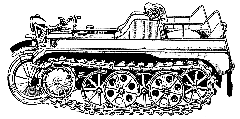NSU Kettenkrad Homepage |
 |
The Kettenkrad was designed as an off-road tractor, capable to tow a small trailer or a small gun (2 cm FLAK oder 3,7 cm PAK). It carries the driver and two passengers. The passengers are seated backwards at the rear.
The Kettenkrad is not armo(u)red and not armed. At least early models had three riffle brackets for the crew's K98 carabines.
From the factory the Kettenkrad never had any external brackets for tools, showels or jerrycans.
| Manufacturer | NSU Motorenwerke AG, Neckarsulm, Germany |
| Type | HK 101 |
| Military type | Sd.Kfz 2 |
| Measures and weights: | |
| Length | 3 metres (9 ' 10") |
| Width | 1 metre (3' 3") |
| Height | 1.20 metres (3' 11") |
| Unladen weight | 1235 kg (2726 lbs) |
| Payload | 325 kg (717 lbs), including driver |
| Combat weight | 1560 kg (3444 lbs), including crew of 3. Only 95 kg (210 lbs) of this weight is carried by the front wheel, the rest is on the tracks. |
It is a small vehicle |
|
| Driving performance: | |
| Top speed | Driver's manual says 70 km/h (44 mph), other sources
say 80 km/h (50 mph), postwar title says 61 km/h (38 mph) |
It is fast... |
|
| Engine (Motor): | |
| Manufacturer | OPEL (German daughter company of GM) |
| Type | Four cylinder in line watercooled OHV engine |
| Capacity | 1478 ccm |
| Bore | 80 mm |
| Stroke | 74 mm |
| Compression ratio | 1 : 6 |
| Performance | 36 bhp (26 kW) at 3400 rpm |
| Carburetter | SOLEX downdraught off-road carburetter 32 FJ-II (The first 500 Kettenkrads and all postwar Kettenkrads had a standard OPEL (System Carter) carburetter) |
| Electrical system: (Thanks god, it's BOSCH!) | |
| Voltage | 6 Volts, negative ground |
| Generator | 6 Volts, 75 W |
| Battery | 6 Volts, 75 Ah |
| Spark plugs | BOSCH W145T1, gap 0.65 mm Modern plugs: BOSCH W8AC or BERU 14-8AU or NGK B5HS or Champion L90C |
| Firing order | 1 - 3 - 4 - 2 (Cylinder 1 = At the rear, water pump / pulley side) |
| Contakt breaker | point gap 0,4 - 0,45 mm |
| Ignition timing point | 30° before t.d.c. (full advanced) |
| Suspension: | |
| Front wheel | 3.50-19 (Air pressure: 1,7 atü = 25 psi) |
| Tracks | Zpw 51/170/120, 40 links per track |
| Track pads | W02 |
| Wheels | Road wheels 450 mm diameter, idler wheel 410 mm diameter. (Very early Kettenkrads have bigger idler wheels) |
The engine comes from the well known OPEL OLYMPIA car. NSU was a motorcycle factory and produced only one cylinder engines with up to 600 ccm, which were not powerful enough for the Kettenkrad. To save the work and the time for the developing of an own engine, NSU took the reliable OPEL engine from the stock. The OPEL OLYMPIA car was in Wehrmacht use, too, so the mechanics in the field knew the engine.
Gearbox:
Gearbox with 3 forward gears and 1 reverse gear, plus transfer box for "Gelände" (off-road) und "Straße" (road). So in total there are 6 forward and 2 reverse gears.
Fuel consumption:
On the road: 16 liters/100 km (18 mpg (imperial))
Off road: 22 litres/100
km (13 mpg (imperial)) and more, depending on the terrain.
The fuel tank capacity is 2 x 21 liters. So each of the two fuel tanks can take a full jerrycan plus a little more. The fuel tanks are located to the right and to the left of the driver.
| Capacities | |
| Petrol/Gasoline: | 2 x 21 l = 42 l regular, leaded or unleaded, min. 74 octane |
| Engine/Motor: | 3.2 l Einheitsöl der Wehrmacht. Today: Engine oil SAE 15W-40 |
| Gearbox: | 1.2 l Einheits-Getriebeöl der Wehrmacht / CASTROL Manual EP 80W API GL4 |
| Steering gear | 1.0 l Einheits-Getriebeöl der Wehrmacht / CASTROL Manual EP 80W API GL4 |
| Radiator fan | 0.075 l (75 cm³) Einheits-Getriebeöl der Wehrmacht / CASTROL Manual EP 80W API GL4 |
| Seitengetriebe | 0.450 l (450 cm³) Fliessfett. Mixture from 1 part gearbox oil and 1 part grease. Known as Ambroleum. Today: SHELL RETINAX G |
| Cooling system | 14 l water with anti freeze |
| Front fork (hydraulic) | 0.115 l (115 cm³) Brake fluid DOT 3 oder DOT 4 |
®Andreas Mehlhorn, 2002-2025